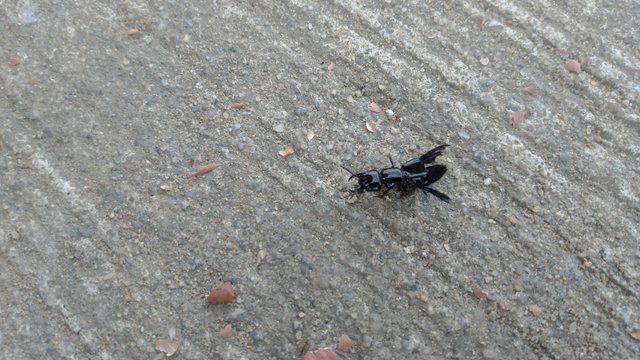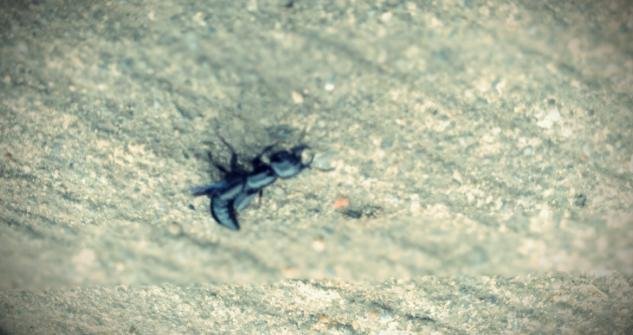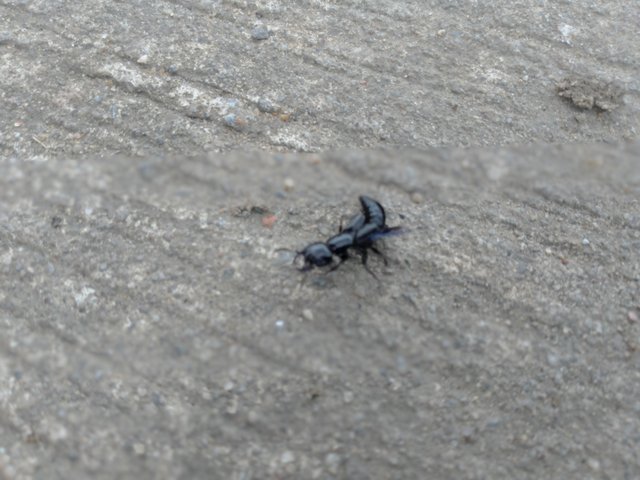Devil's coach-horse beetle(Ocypus Olens), Uyo-Nigeria
This beetle has been linked with the Devil since the Middle Ages, and its common name, which has been used at least since 1840.
Other names include devil's footman, devil's coachman, and devil's steed.The beetle is sometimes also known as the cock-tail beetle because of its habit of raising its abdomen.
The specie is O.olens, genus-ocypus, from staphylinidae family and Order of Coleoptera and Insecta class.
Habitat
Where can this insect be found?
These very common and widespread beetles are present in most of Europe and in North Africa. They have also been introduced to parts of the Oregon, Canada, Washington, California, and parts of British Columbia. It is rarely found in this part of Africa, Nigeria, that is why it really captured my interest and aroused my curiosity to learn about this insect when I came across it.
They prefer to stay in areas with damp conditions and can be found from April to October in heath and moorland, meadows woodlands, hedgerows, parks and gardens. During the day, they commonly stay under stones, logs and leaf litter.
Description
It has an elongated-body, and is black in colour. It is about 20–32 mm (13⁄16–1+1⁄4 inch).
The beetle is one of the larger British beetles. Its wing covers (called elytra) are short, covering only its thorax, exposing it's abdominal segments. It has powerful abdominal musculature and the abdominal segments are covered with sclerotized plates.
This beetle is capable of flight, but its wings are rarely used.

It is covered with fine, black hairs. The Devil's coach-horse beetle is well known for its habit of raising its long and uncovered abdomen and opening its jaws, rather like a scorpion when it is threatened. This insect has no sting, but can give a painful bite with its strong, pincer-like jaws.
It also capable of emitting a foul-smelling odour, as a defensive secretion, from a pair of white glands at the end of its abdomen.
Mode of feeding
It is a predator, hunting mainly by night, feeding on a range of invertebrates, including worms, slugs, spiders, and woodlice, as well as carrion. The prey is caught in the mandibles, which are also used to cut and together with the front legs to manipulate the food into a bolus. The bolus is repeatedly chewed and swallowed, emerging covered with a brown secretion from the foregut, until it is reduced to a liquid that is digested. Skin in the case of earthworms and hard materials from arthropods are leftover. The larvae are carnivorous with similar eating habit.
Reproduction
Ocypus olens mates in autumn. Females lay their eggs from 2–3 weeks after first mating. They are large (4 mm or 3⁄16 inch) and white with a darker band and laid singly in damp conditions under moss, stones, cow manure, or leaf litter. After around 30 days, the eggs split and the larvae emerge, white with a straw-coloured head.The larva lives largely underground, and feeds on similar prey to the adult and has the same well-developed mandibles. It also displays same wide open jaws and raised tail when threatened.
The larva goes through three stages of growth (this is called instars), the final stage ranging from 20 to 26 mm in length. It take about 150 days old, for the larva to pupates and about 35 days to emerges as an adult with its natural colouring, fully formed except for the wings, which cannot be folded neatly beneath the elytra for several hours.
Adults Devil's coach-horse beetle can survive a second winter, some by hibernating in burrows and not emerging until March, while others remain active.
Have you ever come across the Devil's coach-horse beetle? Or what do you know about species of other insects? Please tell us @nspidoz, @chant, and @imohmich.
Thanks to @joslud for this naturally oriented contest.
I appreciate all that took time to read my post.
All pictures are taken by the author using NokiaC30






x-link
https://x.com/rubees4life/status/1966424557255876721
🎉 Congratulations, @rubee2as1!
Your post Devil's coach-horse beetle(Ocypus Olens), Uyo-Nigeria was rewarded by CCS Curation Trail
“Home is where your heart is ❤️.”
👉 Join the CCS Curation Trail | Community Invitation
✅ Vote for visionaer3003 as witness
Thank you @ccscurator!
Welcome. 🦗🦋🕷Entry N° 1
Meet Eco-Lens Map
Hi, my feedback for you.
Your post was excellent in terms of research, and you included the relevant references. It was great that you talked about your experience with the insect. You included the taxon (remember to clearly indicate where you took it).
The weakness was the photography and its editing. Flipping the photo doesn't make it different. It's not necessary to add text with the name on the photos. The video, which is barely 5 seconds long, is really unnecessary; it contributes nothing.
Congratulations on your discipline in commenting on the other posts. Keep it up.